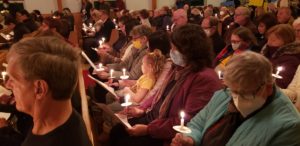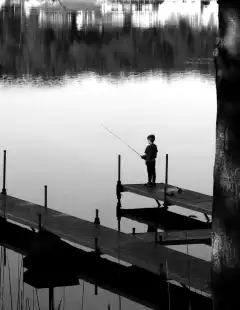By Tom Travis
I’m writing this on the first anniversary of Russia’s invasion into Ukraine. Soon after Putin’s unprovoked invasion last year I reached out to some local Ukrainians for their reactions. I soon found out they all wanted to talk. They all wanted to share their unique stories and emotions about the impending doom of their beloved Ukraine.
There was a deep emotional tie that emerged as I interviewed local Ukrainians about the connections they had to their “homeland.” The interviews were filled with tearful and anxious stories of feeling hopeless about their relatives so far away and under a cloud of doom. They told stories of frantically calling, emailing and messaging their friends and family members thousands of miles away. Their relatives in Ukraine were telling their American connections they were abandoning their homes and apartments to find safer places within the interior regions of the country.

The local Ukrainian community gathered for a prayer vigil in March 2022. (Photo by Tom Travis)
A prayer vigil was organized at the Ukrainian Church in early March on the northwest side of Flint. The vigil served as a time of prayer and community for local Ukrainians and it was a plea to the Flint and surrounding community for humanitarian aid. Personal supplies, clothing and cash flowed in from all over. And now a year later, the world has watched to see even though Vladimir Putin’s war rages on the Ukraine nation has become emboldened. The U.S. and many nations around the world are playing a delicate and careful game of supporting Ukraine while trying not to poke the “Bear” to the north that could unleash a global nuclear Armageddon.
Interviewing and spending time with the close-knit Ukraine community steeped in cultural traditions caused me to ask myself, “Where am I from? What is my cultural heritage?”
I’ve always been envious of friends who could tout their cultural or ethnic heritage by saying , “I’m an Italian-American. I’m African-American. I’m a proud Irish Catholic,” etc.
Aside from knowing that my dad was born and raised on a farm and attended a one-room schoolhouse in Flushing near Coldwater and Webster Roads, and that my mom grew up in the north end of Flint, attending Civic Park school and graduating from Northern High School, I didn’t know much more about our family.
A family genealogist
That mystery of where my family came from all changed several years back when my sister took on the task of becoming our family’s genealogist. She searched out local genealogical resources, traveled to cemeteries to gather tomb stone information with tracing paper in hand, she researched online and in-person birth, baptism, marriage and death records.
Over the years her research continued creating volumes of research on our own family, her husband’s family and even the family histories of her friends and neighbors’. My sister started her search for our family’s roots in the Flint Public Library’s genealogy room (Now located in the basement of the newly remodeled FPL.).
As the research grew she revealed lists of ancestors and pages of family trees. At our annual family reunions held each August in Flushing Park, my sister rolls in with three-ring binders filled with her research. The binders include family documents, newspaper articles about ancestors and black and white photographs helping us to put a face to names we’ve heard about all our lives.

My great-grandparents Isaac and Bertha Smith. The child is my grandfather, Clare Orville Smith born in 1895. (Photo source: Travis family photo)
Rather than bore you with the long list of ancestors and litany of begats I’ll offer these highlights.
Both my mother’s line and father’s line of ancestors have been in this country since the early 1600s. In fact, through my great-grandmother Helen’s line it was discovered that our first ancestors came to the U.S. from England on the famed Mayflower which arrived in 1621.
That ancestor was the Mayflower passenger Gov. William Bradford, a Puritan separatist who came to the U.S. looking to loose the grip of The Church of England. It is said that on the trip Bradford led prayer meetings for the 102 passengers. Eventually, he became the Governor of the Plymouth Colony. Another ancestor through my father’s line landed on our shores a few years after the Mayflower.
So my family, my people, have been in the United States for a long time. An ancestor of my great-grandmother’s side through my mother’s line, Bertha, landed in Boston from England in 1637.
According to DNA testing, my family line is 79% from England, Northwestern Europe, Channel Island, Wales, Switzerland, Netherlands, Luxembourg, Isle of Man, Germany, France, Belgium, Austria, Czech Republic, Hungary, Russia, and Slovenia. Conclusion: I’m white!
More interesting to me, rather than which countries my people came from, are some of the unique and quirky names my ancestors had, like: my great-grandparents’ names were Isaac Newton Smith and Bertha Alvaretta Hart, then in 1685 there’s my eighth great-grandfather Sampson Mason who named his son Palatiah; he married Hapzibah and they had two daughters named Bethia in 1665 and Thankful (Travis) in 1672. Bertram Round, my fifth-great-grandfather, was born in 1741. More of my ancestors’ names include Eliphalet, Philoathia, Jerusha, Content, Israel Dwinnel, Flavia, Submit Pineo, Return Babcock and my favorite, Freelove Harrington.
There are roadblocks in doing genealogy research. Records are lost or destroyed in fires and floods. Courthouses, churches and family bibles are common places for important documents to be stored. If these key documents are destroyed linking the present to the past family’s stories can be gone forever.
It is powerful and deeply meaningful knowing your roots, where you came from and who your people are. Genealogy has allowed me and my family to be connected to our past by learning the names of our ancestors who served in World Wars I and II, the Spanish American War, the Civil War, the American Revolution. We’ve learned which ancestors had religious affiliations and which ones had none. We learned about those who were prominent and helpful people in their times and others who were, well shall we say, not so helpful.
Activist Angela Davis’ ancestors and mine came over on the Mayflower
My sister in her research is not alone. It seems that in recent years there has been a push calling for people to research their roots and build a family tree. Henry Louis Gates, Jr. has made discovering one’s ancestry popular with his PBS show “Finding Your Roots.” As the host, Gates invites a celebrity or public figure to sit with him at a table. The guest will discover what Gates has uncovered about their ancestors and family tree. Sometimes the revelations are intense and dumbfounding or even outright unbelievable. Like when it was revealed that Actor Larry David who has famously portrayed Senator Bernie Sanders on SNL and other venues that David and Sanders are actually related.
As Davis turned the pages of the book prepared by Gates she was shocked to learn that her ancestry included several White men who had enslaved people. One ancestor was a white attorney in the south. Speechless, Davis sat looking at the evidence that she had an ancestor that who was white — and a prominent attorney. Davis, looking at Gates said, “To be a white, educated southern attorney you had to belong to a group like the Klu-Klux-Klan or other white supremacy groups. Davis concluded, still looking shocked, “It’s good to know my genealogy history. It’s good to know my ancestry. Even though they’re not necessarily my people.”
I confess, as I look back on my family’s lineage, I too don’t know quite what to say as Davis struggled to find the words. While I don’t know the thoughts and philosophies my ancestors operated from, one thing is almost certain, they were white.
The Mayflower arrived around the time the 1619 enslaved shipping trade routes were established. When I think about the Black Lives Matter protests that erupted in 2020, some that I marched in and others I reported on as a community journalist, it makes me cringe to think that my ancestors could have, and most likely did, play a part in the advancement of the evil of slavery.
Resources genealogy research
African-Americans often find roadblocks in following their ancestry because the records of enslaved people didn’t survive over the years or weren’t ever recorded. A helpful link for African-Americans to search for their family records is enslaved.org.
If you get the urge to discover your family tree which can be an often overwhelming and never ending task, my genealogist sister suggests to begin your journey at the Flint Public Library genealogy department. Also, the Flint Genealogical Society (FGS) has many resources for genealogy beginners (flintgenealogy.org). The FGS meets regularly and invites beginners to attend to learn more about searching for ancestors. Another genealogy resource is Familysearch.org which offers free resources.
EVM Managing Editor Tom Travis can be reached at tomntravis@gmail.com.


You must be logged in to post a comment.